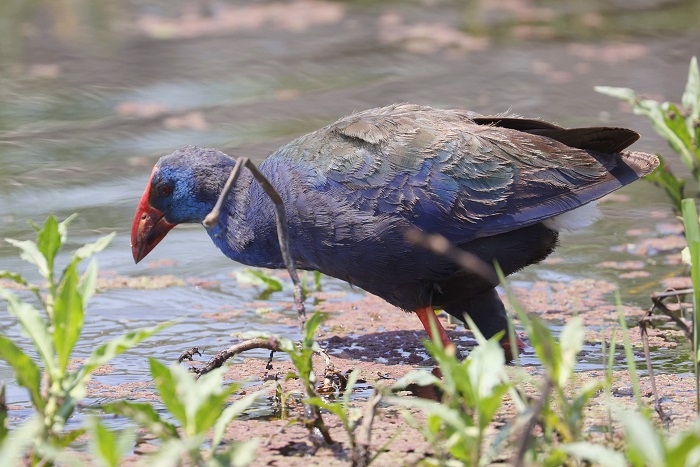Cover image of African Swamphen by Roelof van der Breggen – Glen Austin Pan, Gauteng – BirdPix No. 289893
Swamphens belong to the Family: RALLIDAE. This family also includes Crakes, Rails, Flufftails, Gallinules, Moorhens and Coots etc. Their physiology is diverse, but most have laterally compressed bodies, short tails, short rounded wings and well developed legs and feet. The bill structure is variable. Most birds in this family inhabit wetlands or forest undergrowth and are usually vocal and highly secretive.
Identification
The African Swamphen is a vibrantly coloured, blue, purple and green waterbird. It is easily identified by its heavy red bill, red frontal shield and long red legs. The sexes alike in plumage coloration.
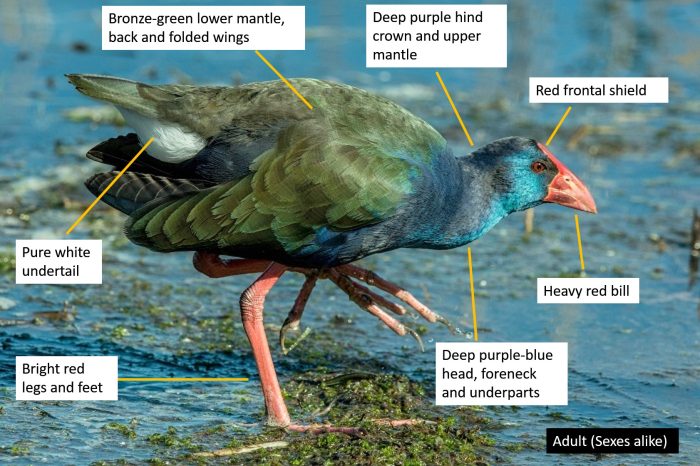
Garden Route National Park, Western Cape
Photo by Jean Hirons
In adults, the head, foreneck and underparts are deep purplish blue. The face and throat are a paler, brighter blue. The hind crown and upper mantle are dark purple. The lower mantle, back and folded wings are bronze-green. The rump and upper tail are dark olive-green and the undertail is pure white. The bill and frontal shield are bright red while the legs and feet are pinkish-red.
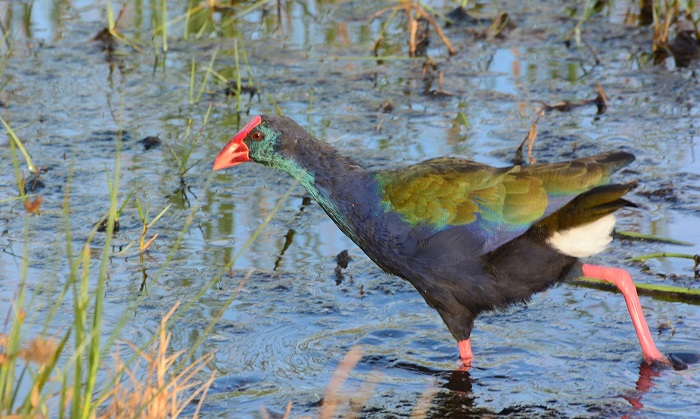
Sedgefield Lagoon, Western Cape
Photo by Ryan Tippett
Immature birds resemble the adults but have duller blue upperparts and the underparts, from the breast to the vent are mottled dark grey and white. Juveniles are dull brown above and grey below, often with white mottling on the flanks and belly. The bill and frontal shield are brownish-red and the legs and feet are dull red.
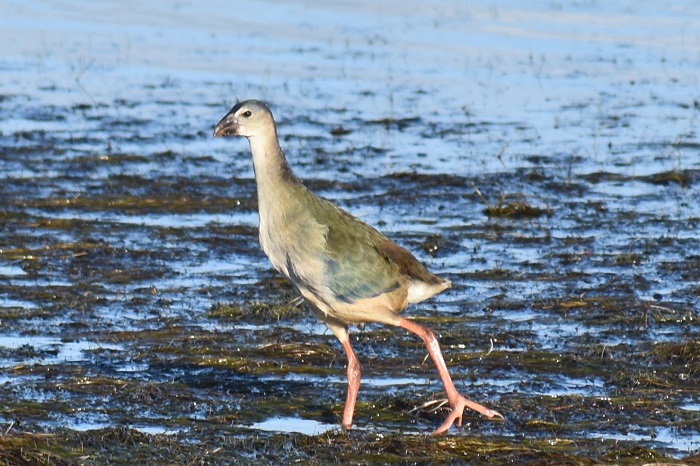
Swartvlei, Sedgefield, Western Cape
Photo by Karis Daniel
The African Swamphen is by far the largest gallinule in the region, helping to reduce confusion with the smaller Purple Gallinule (Porphyrio martinicus) and Allen’s Gallinule (Porphyrio alleni). The Purple Gallinule is a very rare vagrant to southern Africa and is smaller, with a yellow bill tip and yellow (not red) legs and feet. Allen’s Gallinule is much smaller, with a bright blue frontal shield.
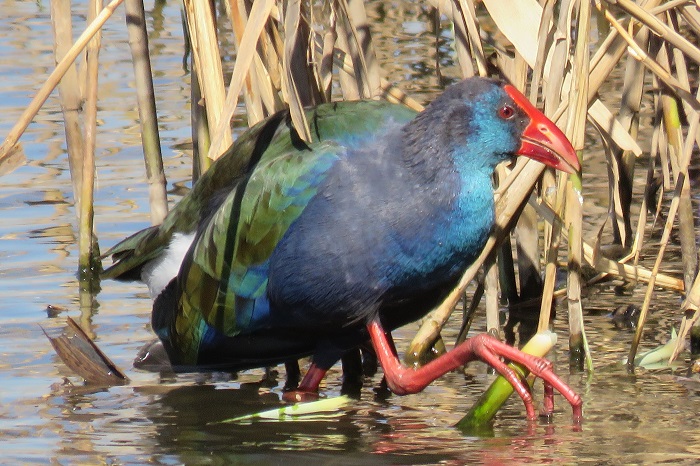
Rietvlei, Gauteng
Photo by Anthony Paton
Status and Distribution
The African Swamphen occurrs in several scattered populations from Senegal east to Ethiopia and with an outlying population in the Nile River valley, Egypt. It also occurs on Madagascar. The African Swamphen is more continuously distributed in East, Central and Southern Africa. It is widespread but patchily distributed in South Africa and is absent from most of the arid Karoo and Kalahari.
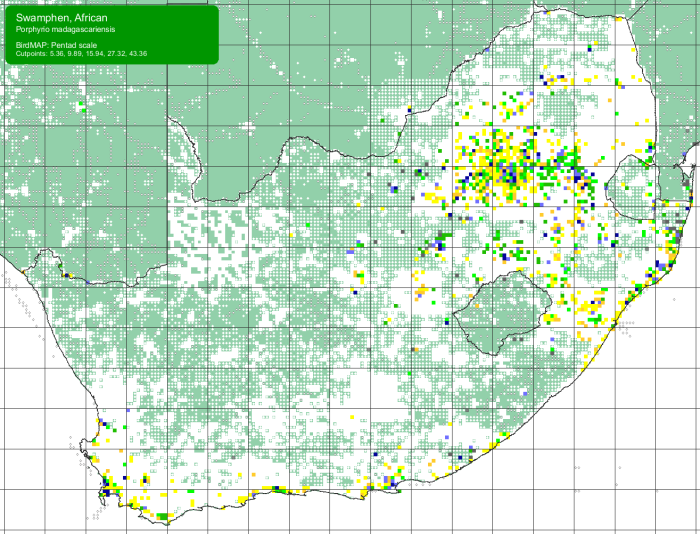
The African Swamphen is not threatened. Numbers may have decreased locally because of frequent disturbance, removal of riparian vegetation, and from wetland drainage. Similar decreases have been reported from some other parts of Africa. However, the African Swamphen readily makes use of man-made wetlands like dams and sewage ponds, and may have expanded its distribution as a result.
.
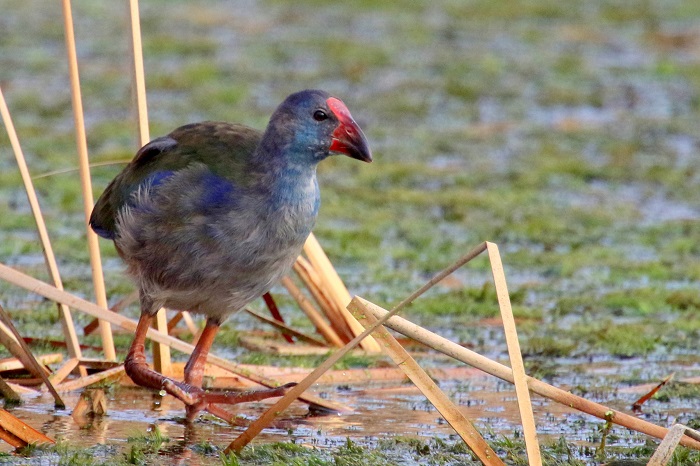
Marievale Bird Sanctuary, Gauteng
Photo by Lia Steen
Habitat
The African Swamphen inhabits lakes, dams, pans, slow flowing rivers, marshes and estuaries. It occurs at large or small waterbodies and prefers permanent habitats, although it does also utilise temporary wetlands. The African Swamphen occupies both fresh and brackish habitats that are sheltered, and with still or slow flowing water fringed or overgrown by reeds (Phragmites spp), Bulrushes (Typha capensis), sedges and Papyrus (Cyperus papyrus) etc.

Wakkerstroom, Mpumalanga
Photo by Ryan Tippett
.
Behaviour
The African Swamphen is mostly a sedentary resident. It is usually encountered solitarily or in pairs but may sometimes be found in groups of 12 or more birds. The African Swamphen does not undertake any regular migrations. It is sometimes locally nomadic in drier areas and undertakes occasional, large-scale seasonal movements in response to changing habitat conditions.
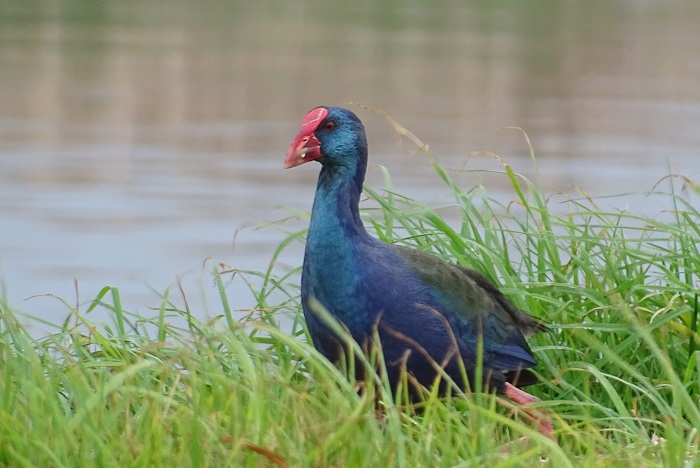
Strandfontein Water Treatment Plant, Western Cape
Photo by Josu Meléndez
The African Swamphen usually remains within dense vegetation, but sometimes ventures out to forage in the open, seldom venturing far from cover. It walks out on water lilies, and runs fast through marshy vegetation. It flicks its tail frequently, which is thought to indicate uneasiness or fear, but is also used in display and to warn off predators.
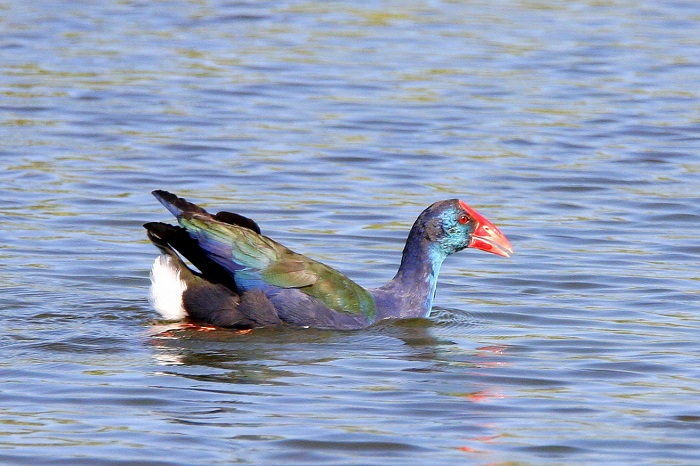
Marievale Bird Sanctuary, Gauteng
Photo by Lia Steen
The flight is heavy and clumsy. During short flights the legs dangle below the body, but are held out straight in longer flights. The African Swamphen is known to construct platforms on which to stand or roost by taking reed or rush stems in the bill and folding them over before standing on the bent stems to force them in place.
The African Swamphen bathes in shallow water by flapping its wings and submerging the head. Also sunbathes after preening and may climb to the top of a tall plant to do so.
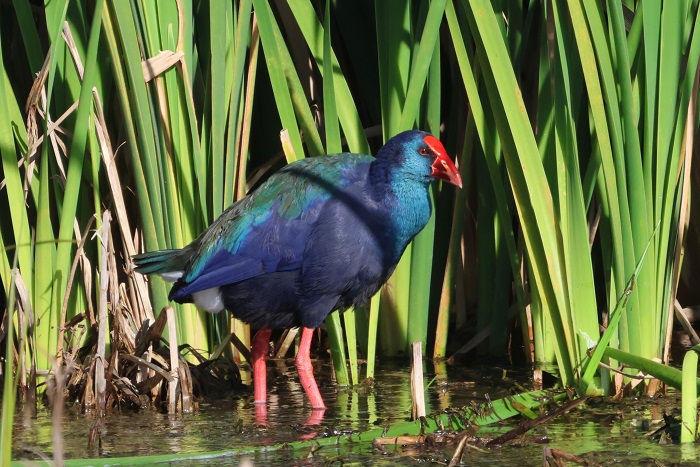
Strandfontein Waste Water Treatment Works, Western Cape
Photo by Gerald Wingate
The African Swamphen is largely vegetarian and consumes a variety of plant matter, including roots, stems, leaves, flowers and seeds. They are especially partial to water lily tubers. The African Swamphen prefers feeding on tender new growth and the soft, pulpy centre of old reed stems. The diet also includes a variety of animal prey including invertebrates like insects, snails, worms, leeches and crabs, as well as vertebrates such as small fish, frogs, and bird nestlings. They also eat frog and fish eggs, bird eggs and carrion.
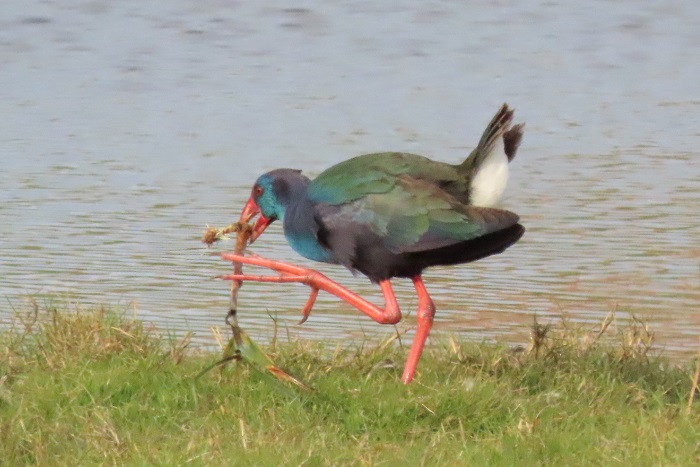
Tableview, Cape Town, Western Cape
Photo by Les Underhill
The African Swamphen forages by clambering around in marshy vegetation. It pulls down plant stems with the bill, holding them with one foot before biting off pieces to eat. May also immerse its whole head and neck to reach soft, under water plant stems. They often climb the stems of reeds and Bulrushes to reach flowers and seed heads. The African Swamphen also digs in damp soil for roots and turns over stones and floating vegetation to reveal prey.
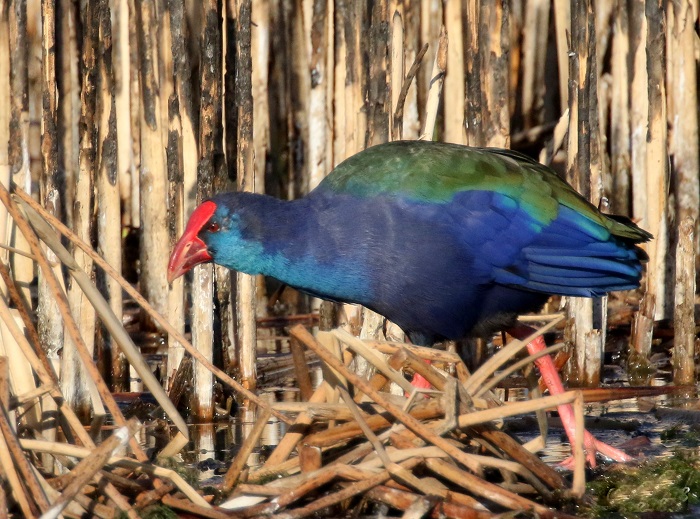
Marievale Bird Sanctuary, Gauteng
Photo by Lia Steen
The African Swamphen is a monogamous, cooperative breeder. They are strongly territorial and territories are aggresively defended, mostly by the males. Territory establishment is accompanied by increased vocalisations.
The nest is built by both sexes. They are sometimes also assisted by helpers (the young of previous broods). The nest is a bulky bowl-shaped structure built from Bulrushes, reeds, grass etc. It is built on top of a pre-prepared platform of flattened vegetation. The bowl is sometimes lined with grass, papyrus flower heads or fern leaves. The stems of adjacent vegetation are often drawn over the nest to form a canopy. The nest is almost always built over water and well concealed in dense vegetation.
Eggs are laid throughout the year, but mainly from October to March in southern Africa. Clutch size varies from 2 to 6 eggs. The eggs are cream-coloured with reddish-brown and grey speckles.
Incubation begins once the full clutch has been laid and takes around 25 days for the eggs to hatch. The female performs most of the incubation with help from the male and helpers if present. The newly hatched young are precocial and leave the nest shortly after hatching. They return to the nest for feeding and to roost. The young are cared for by both sexes and any helpers if present. They are fully fledged after 8 weeks.
Further Resources
Species text from the first Southern African Bird Atlas Project (SABAP1), 1997.
The use of photographs by Anthony Paton, Gerald Wingate, Jean Hirons, Josu Meléndez, Karis Daniel, Les Underhill, Lia Steen and Roelof van der Breggen is acknowledged.
Virtual Museum (BirdPix > Search VM > By Scientific or Common Name).
Other common names: Porphyrio porphyrio (Alt. Scientific); Purple Gallinule, African Purple Swamphen (Alt. English); Grootkoningriethaan (Afrikaans); Purperkoet (Dutch); Talève d’Afrique (French); Purpurhuhn (German); Caimão-comum (Portuguese)
A list of bird species in this format is available here.
Recommended citation format: Tippett RM 2024. African Swamphen Porphyrio madagascariensis. Biodiversity and Development Institute. Available online at https://thebdi.org/2024/09/08/african-swamphen-porphyrio-madagascariensis/
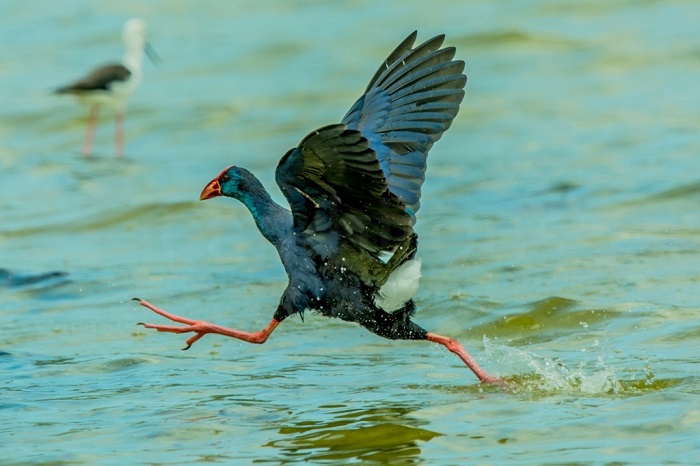
Garden Route National Park, Western Cape
Photo by Jean Hirons

